|

LATEST COLLECTIBLES ARTICLE______________________________
Ghosts, Goblins, and
More
by Bob Brooke
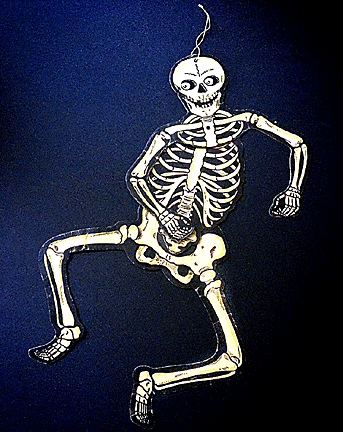 As
Halloween approaches, collectors seek out antique Halloween
collectibles. These treasures embody the nostalgic spirit of the holiday
and provide a glimpse into how Halloween enthusiasts celebrated in the
past. From spooky decorations to eerie costumes, Halloween collectibles
can be both valuable and captivating. Unlike modern mass-produced
decorations, antique and vintage pieces have historical significance,
craftsmanship, and most importantly—rarity. As
Halloween approaches, collectors seek out antique Halloween
collectibles. These treasures embody the nostalgic spirit of the holiday
and provide a glimpse into how Halloween enthusiasts celebrated in the
past. From spooky decorations to eerie costumes, Halloween collectibles
can be both valuable and captivating. Unlike modern mass-produced
decorations, antique and vintage pieces have historical significance,
craftsmanship, and most importantly—rarity.
By the beginning of the 19th century, small cottage workshops had begun
to make paper skeleton die-cuts to hang in windows. Later, others began
producing chalkware figurines of witches or ghosts, wood and tin
noisemakers, ghoulish board games, papiér-mache pumpkins to hold candy
or candles, and elaborate costumes and masks.
 But
the trick-or-treating tradition wasn’t widespread in the United States
until the 1930s. Though sugar-rationing in the 1940s put a damper on
many Halloween parties, the celebration bounced back in the 1950s with a
focus on children, cemented by Walt Disney’s short film, “Trick or
Treat,” in 1952. Generally, vintage Halloween collectibles range from
the 1920s to the 1960s. But
the trick-or-treating tradition wasn’t widespread in the United States
until the 1930s. Though sugar-rationing in the 1940s put a damper on
many Halloween parties, the celebration bounced back in the 1950s with a
focus on children, cemented by Walt Disney’s short film, “Trick or
Treat,” in 1952. Generally, vintage Halloween collectibles range from
the 1920s to the 1960s.
Vintage Halloween collectibles came in several categories—masks,
decorations, candy containers, noisemakers and rattles, embossed die-cut
decorations, chalkware, party decorations, postcards, papier-mache
lanterns, and costumes and accessories. The items in these categories
sell for anywhere from $20 to over $300 while some of the rarer ones can
sell for thousands. The most valuable Halloween decorations are, believe
it or not, papier-mache Jack-o-Lanterns. These German-made lanterns have
become the most popular Halloween collectible. .
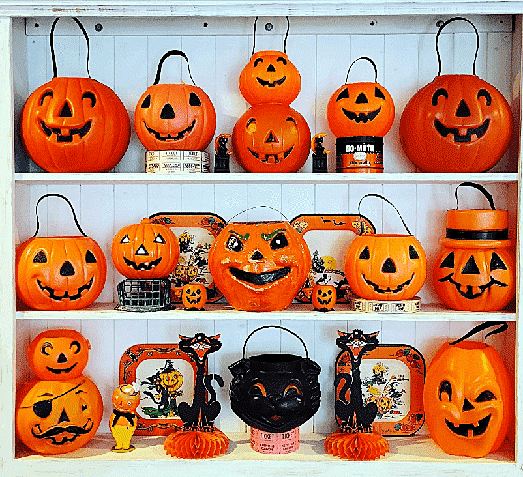
Halloween Masks
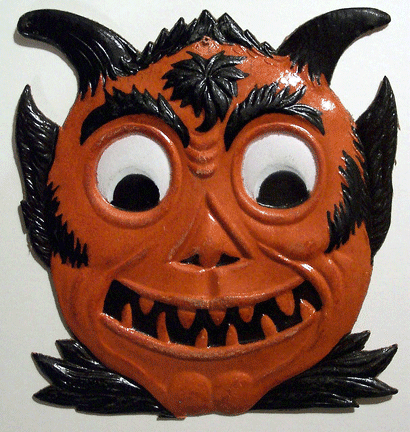 Vintage
masks are one of the most sought after Halloween collectibles. People in
the 1950s often made these masks from papier-mâché, rubber, or latex,
making them popular collectibles. Collectors look for intricate designs,
original paint, and unique features that reflect the style of the time.
They especially value masks from well-known manufacturers like Ben
Cooper or Collegeville. Vintage
masks are one of the most sought after Halloween collectibles. People in
the 1950s often made these masks from papier-mâché, rubber, or latex,
making them popular collectibles. Collectors look for intricate designs,
original paint, and unique features that reflect the style of the time.
They especially value masks from well-known manufacturers like Ben
Cooper or Collegeville.
Early Halloween Decorations
 Antique
Halloween decorations offer a glimpse into how people celebrated it in
the past. Early decorations made from materials like cardboard, crepe
paper, or tin are popular with collectors. They particularly like
lanterns, garlands, and window silhouettes that feature classic
Halloween motifs like witches, ghosts, and jack-o’-lanterns. Condition
and rarity both affect their value. Antique
Halloween decorations offer a glimpse into how people celebrated it in
the past. Early decorations made from materials like cardboard, crepe
paper, or tin are popular with collectors. They particularly like
lanterns, garlands, and window silhouettes that feature classic
Halloween motifs like witches, ghosts, and jack-o’-lanterns. Condition
and rarity both affect their value.
Halloween Candy Containers
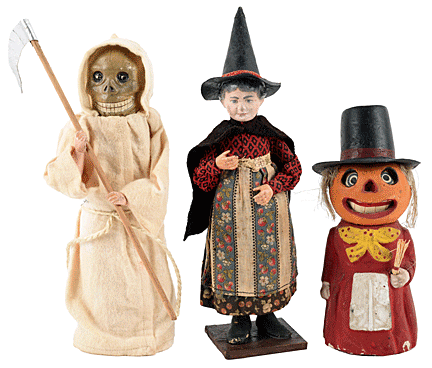 Celebrating
Halloween is synonymous with candy. Manufacturers produced containers
made of papier-mache, composition board, and plastic. Often designed to
look like pumpkins, witches, or ghosts, candy containers add a touch of
whimsy to Halloween decor. People used these containers, originally made
from tin or cardboard, to hold candy and often brightly colored them
with distinctive designs. Rarity, condition, and the intricacy of their
design determines their value. Celebrating
Halloween is synonymous with candy. Manufacturers produced containers
made of papier-mache, composition board, and plastic. Often designed to
look like pumpkins, witches, or ghosts, candy containers add a touch of
whimsy to Halloween decor. People used these containers, originally made
from tin or cardboard, to hold candy and often brightly colored them
with distinctive designs. Rarity, condition, and the intricacy of their
design determines their value.
Tin Noisemakers and Rattles
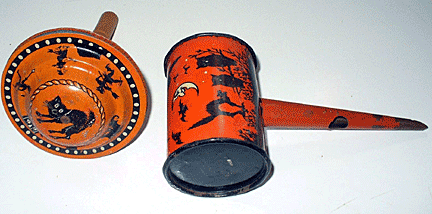 Tin
Halloween noisemakers, made from the 1920s to the 1950s, feature
colorful lithographic designs that captured the artistic style of the
mid 20th century. They came in a variety of forms and many different
styles featuring the usual Halloween themes and symbols–devils, witches,
black cats, ghosts, pumpkins, owls, and more. Noisemakers range from
paper to metal. Earlier examples of metal noisemakers featured wooden
handles, later replaced by plastic ones. Most vintage noisemakers sell
for $15 to $75, with some commanding prices into the hundreds depending
on scarcity, age, style, images, and manufacturer. Tin
Halloween noisemakers, made from the 1920s to the 1950s, feature
colorful lithographic designs that captured the artistic style of the
mid 20th century. They came in a variety of forms and many different
styles featuring the usual Halloween themes and symbols–devils, witches,
black cats, ghosts, pumpkins, owls, and more. Noisemakers range from
paper to metal. Earlier examples of metal noisemakers featured wooden
handles, later replaced by plastic ones. Most vintage noisemakers sell
for $15 to $75, with some commanding prices into the hundreds depending
on scarcity, age, style, images, and manufacturer.
Embossed Die-Cut Decorations
 Beistle
Company’s embossed die-cuts represent some of the most recognizable
vintage Halloween imagery. These three-dimensional decorations featured
classic motifs like skeletons, witches, black cats, and grinning
pumpkins. Die-cuts prices range in price from $20 to an astonishing
$6,850, a world record paid for a rare Beistle piece. Beistle
Company’s embossed die-cuts represent some of the most recognizable
vintage Halloween imagery. These three-dimensional decorations featured
classic motifs like skeletons, witches, black cats, and grinning
pumpkins. Die-cuts prices range in price from $20 to an astonishing
$6,850, a world record paid for a rare Beistle piece.
Halloween Chalkware
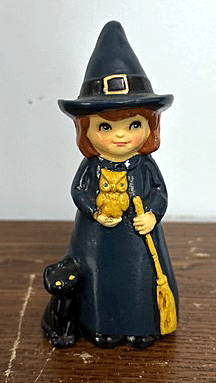 Made
out of plaster of Paris, manufacturers produced chalkware to create
inexpensive versions of Halloween decorative objects such as figurines.
Some used molds to form chalkware pieces taken from Staffordshire and
other popular figurines. Other makers carved them. In either case, the
chalkware was painted most of the time, usually with a water-based
pigment. It chipped easily, and its fragile colors sat exposed on the
surface of the pieces rather than being fired like a glaze, thus their
beeswax or varnish coatings gave them little protection. Very few pieces
from the early 19th to mid-20th centuries, the heyday of the material,
have survived without dings and scratches. Because it’s so fragile,
chalkware essentially cannot be cleaned, so even pieces that have
survived unscathed often look dingy and careworn. In the United States,
two of the main centers for chalkware production were German-dominated
Lancaster and Philadelphia, Pennsylvania, although the pieces themselves
were almost certainly the work of Italian artisans. Made
out of plaster of Paris, manufacturers produced chalkware to create
inexpensive versions of Halloween decorative objects such as figurines.
Some used molds to form chalkware pieces taken from Staffordshire and
other popular figurines. Other makers carved them. In either case, the
chalkware was painted most of the time, usually with a water-based
pigment. It chipped easily, and its fragile colors sat exposed on the
surface of the pieces rather than being fired like a glaze, thus their
beeswax or varnish coatings gave them little protection. Very few pieces
from the early 19th to mid-20th centuries, the heyday of the material,
have survived without dings and scratches. Because it’s so fragile,
chalkware essentially cannot be cleaned, so even pieces that have
survived unscathed often look dingy and careworn. In the United States,
two of the main centers for chalkware production were German-dominated
Lancaster and Philadelphia, Pennsylvania, although the pieces themselves
were almost certainly the work of Italian artisans.
Halloween Party Decorations
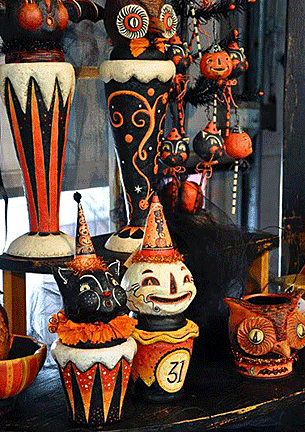 Halloween
party decorations include a lot of paper ephemera—suckerholders, candy
boxes, garlands, diecuts, table decorations, centerpieces, plates, cups,
napkins, treat bags, bridge tallies, nutcups, doilies, invitations,
placecards, kitchenware, signs, candles and candle holders, party books,
and so much more. Halloween
party decorations include a lot of paper ephemera—suckerholders, candy
boxes, garlands, diecuts, table decorations, centerpieces, plates, cups,
napkins, treat bags, bridge tallies, nutcups, doilies, invitations,
placecards, kitchenware, signs, candles and candle holders, party books,
and so much more.
Between the early 1900s to the 1930s, German manufacturers made the
finest papiér-mache items before World War II disrupted production.
German toy companies produced a variety of Halloween candy containers.
Collecting Halloween Memorabilia
The most important thing collectors need to consider when purchasing
Halloween memorabilia is rarity. Pre-1960s Halloween items command
premium prices because so few have survived. These delicate
decorations—crafted from paper, cardboard, and early plastics—were meant
for temporary seasonal use, not long-term preservation.
Limited production runs have added to this scarcity effect. When Beistle
Company produced their iconic embossed die-cut decorations in small
batches during the 1920s to the 1940s, they unknowingly created the most
sought-after collectibles.
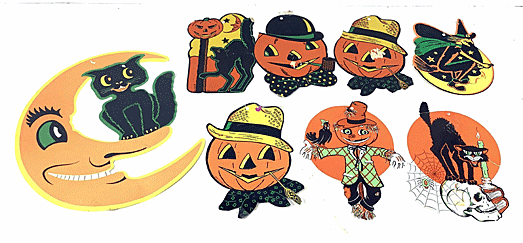
 Condition
is crucial when evaluating the value of antique Halloween collectibles.
Well-preserved items, with minimal damage or wear, are far more
valuable. Collectors should look for collectibles with original paint,
intact materials, and minimal restoration work. Halloween collectibles
that have historical significance or are associated with notable
manufacturers or designers can be especially valuable. Condition
is crucial when evaluating the value of antique Halloween collectibles.
Well-preserved items, with minimal damage or wear, are far more
valuable. Collectors should look for collectibles with original paint,
intact materials, and minimal restoration work. Halloween collectibles
that have historical significance or are associated with notable
manufacturers or designers can be especially valuable.
Halloween collectibles offer a fascinating glimpse into the history of
Halloween celebrations and provide a tangible connection to the
past.
< Back to
Collectibles Archives
|
